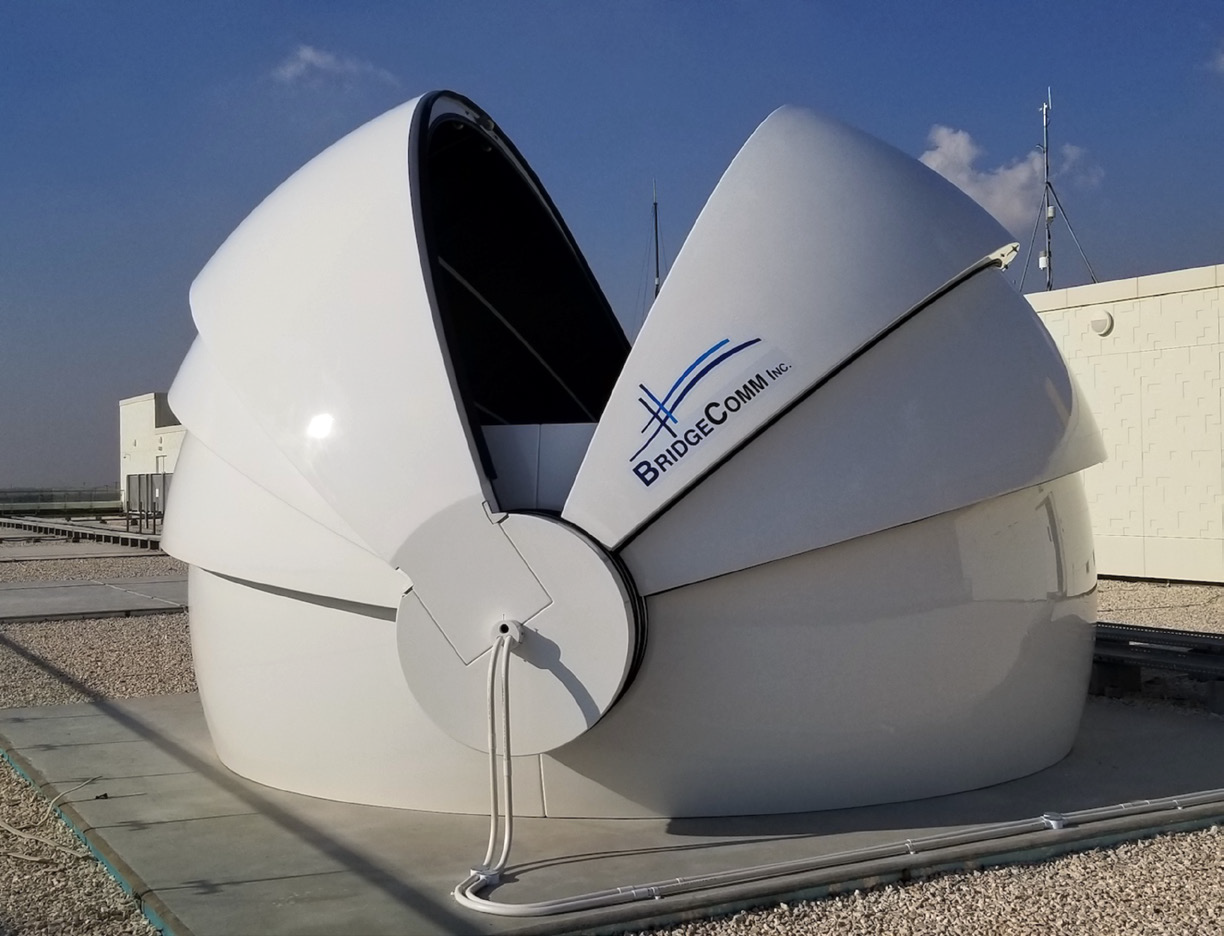As CEO of BridgeComm, Michael Abad-Santos is leading the architecture of a global communications infrastructure for an increasingly data-driven future.
BridgeComm is the only company that offers point-to-multipoint communications utilizing optical wireless communications (OWC). Its highly-mobile, rapidly-deployable multi-point optical laser communications solution enables humans and machines to connect with unlimited flexibility wherever data resides.
A 20-plus year telecommunications and satellite industry veteran, Michael joined BridgeComm in 2019 as senior vice president of business development and strategy. He has held a range of previous executive roles including chief commercial officer at TrustComm, and senior vice president, Americas, at LeoSat Enterprises, where he helped secure pre-series A investments of $20 million, two strategic investment partners and more than $2B in pre-launch contracts for commercial services. Prior to that, Michael also spent more than a decade at Inmarsat, holding several senior executive roles in its U.S. and Global government divisions. Michael is also an independent board member of Gogo Business Aviation.

Mr. Santos, how did you initially become involved in this industry? And what drew you to BridgeComm to further your career?

Michael Abad-Santos
I’ve been in the telecommunications and satellite industry for more than 20 years, initially becoming involved through Inmarsat, where I led the U.S. and Global Government teams. After Inmarsat, I joined TrustComm, Inc., now Oneweb Technologies, as the Chief Commercial Officer. I was really excited to work for a small business that operated very much like a startup. From there, I joined LeoSat Enterprises, one of the original planned Low Earth Orbit (LEO) satellite constellations. I was drawn to LeoSat because I felt that the LEO concept would revolutionize the space and SATCOM markets.
I joined BridgeComm in 2019. The company’s forward-thinking and approach drew me into optical communications, especially our Managed Optical Communications Array (MOCA) technology. I feel that BridgeComm has the capability to revolutionize the space communications industry as well as the communications industry.
BridgeComm was primarily known for its R&D until recently. What changed? How are you leading this transition as CEO?
Michael Abad-Santos
I came on board at a pivotal time for BridgeComm in 2019 as the company’s Senior Vice President of Business Development and Strategy, and shortly after that position, became the firm’s CEO.
Recognizing the expanded potential for BridgeComm, we realized that we were on to what was “next” in communications technology. Every great company starts with a challenge it is trying to solve, and we recognized the need for a new type of global communications solution to either supplement existing infrastructure or stand on its own to meet the growing data demands of the future. We saw this as an opportunity to transition and put our cutting-edge research, innovation and product solutions into practice, and pivot into our next chapter.
As the CEO of BridgeComm, I now have this incredible opportunity to take my 20-plus year telecommunications, satellite, and business development knowledge, and put it to the test by working with some of the best scientists and engineers and innovators to facilitate the next evolution of connectivity.
Tell us more about the challenge you are solving and your mission for the company.
Michael Abad-Santos
There are limits on connectivity as we know it today. The amount of information and data that is being shared daily is incredible, and now with advancements such as digital intelligence, Machine Learning (ML) technologies and Artificial Intelligence (AI), there is an exponential demand for increased bandwidth and connectivity. Plus, as data traffic continues to grow and new vertical industries rapidly emerge, the true potential of 5G — let alone future 6G — isn’t possible with the existing infrastructure.
This isn’t news to anyone in our industry, and they can rattle off these limitations that include congestion, RF availability, spectrum, regulation, costs of laying fiber cables and small cells, launching satellites, etc. In fact, many of us that have spent time in the satellite industry are still focused on providing 3G and 4G coverage to remote areas of the world, which continue to remain without basic communications services.
BridgeComm recognizes these limitations and is introducing a new communications infrastructure, designed for the future in order for humans and machines to interact without constraint. We are working to solve these challenges by developing Point-to-Point (PtP) and Patented Point-to-Multipoint (PtMP) optical solutions — also referred to as Free Space Optical Wireless Communications (FSOC) or Optical Wireless Communications (OWC) and, more commonly, as lazer communications. This new technology can transform communications by unlocking bandwidth and removing limits on connectivity by offering greater flexibility, mobility and reliability. PtMP wireless enables rapid, secure communications network deployment and implementation — for space, air, land, and sea.
What services and products does BridgeComm currently offer for the commercial and Military/Agency/Government (MAG) market segments?
Michael Abad-Santos
BridgeComm is designing optical communications architecture to enhance global connectivity for governments, enterprises, telecom providers, and enabling the new space economy to maintain constant connectivity and run remote operations to ensure the success of their mission.

Currently, we offer PtP OWC solutions for exceptional data transfer rates and ultra-low latency between two direct links. This type of technology is ideal for applications that require secure, instantaneous data exchange between two dedicated, remote connections.
For example, our point-to-point solution can help the government by offering timely, high bandwidth, secure, tactical communications for global forces. Companies in the new-space economy — both commercial and military satellite-based communication networks — can leverage to create inter-satellite connectivity and communications. LEO networks are a great example where reliable, inter-plane broadband connectivity might need to be established to allow the satellites to communicate with one another. Back on the ground, our Optical Ground Station (OGS) terminals are designed to revolutionize communication and tracking capabilities in the realm of space technology by providing high-speed and high-throughput connectivity with satellites.
We also see a demand from telecommunications providers looking to upgrade backhaul infrastructures and provide redundancies in the network. We are aiming to meet an enterprise demand from industrial factories and warehouses to meet future automation and AI and ML implementation. Finally, we can provide optical communications link between airborne terminals for remotely piloted or autonomous aircraft and swarm applications.
What sets BridgeComm apart from other companies in this area?
Michael Abad-Santos
It’s key to note that, while BridgeComm offers P2P FSOC technology today, we will soon be the only company with PtMP OWC communications. Powered by our patented Managed Optical Communication Array (MOCA) technology, this highly-mobile, rapidly-deployable, multi-point optical laser communications solution will offer unlimited flexibility to reliably broadcast information and data to hundreds of receivers and devices. We will be able to offer broadcast-like capability and enhanced security by transmitting data at the speed of light through a low size, weight and power (SWaP), low-cost, modular and scalable solution.
Traditional P2P OWC infrastructures also offer a potential connectivity solution, bypassing the limitations of terrestrial communications, including infrastructure and spectrum constraints. However, these current optical wireless systems are still confined to communication between two points, resulting in expensive and unwieldy deployments of large P2P setups.
On the other hand, P2MP technology allows optical communications systems to act like a highly efficient and reliable broadcast Radio Frequency (RF) to send information to multiple locations simultaneously — all at the speed of light. While still capturing the inherent benefits of optical communications in terms of offering higher resilience, security, more bandwidth, and lower cost, MOCA PtMP is the evolved communications technology of the future.
Please tell us about your focus for the future? What products or services do you envision BroadComm expanding into?
Michael Abad-Santos
This patented MOCA tech that I mentioned will shift the paradigm in communications infrastructure. We believe one-to-many, PtMP broadcast optical communications solutions are multiple steps ahead of the emerging free space optical communication industry. This technology has the potential to lead an evolution of communications infrastructure by unlocking a new era of high-speed, secure, and reliable data transmission. Imagine how much data our technology requires today — now imagine the possibilities of the types of applications and communications devices we can enable tomorrow if we’re not limited by spectrum management, RF frequencies or infrastructure. The potential of what free space optical wireless can enable from an infrastructure and communications perspective is limitless.
Our initial focus for PtMP MOCA technology will be in the space domain, which is rapidly evolving. This is an ideal environment for optical wireless, and with the emergence of proliferated LEO satellite constellations both in the government and commercial sectors, and the rapid technology refresh cycle as a result, our MOCA based AstroBridge space product line will provide operators more flexibility and resilience than traditional PtP systems.
Additionally, as the world continues to deploy 5G for telecommunications applications, terrestrial PtMP wireless connectivity will be a game changer for telecommunications companies that are struggling with spectrum and infrastructure constraints. MOCA technology can be deployed rapidly as we don’t need to dig trenches for fiber optic cables and require costly and lengthy spectrum applications.
Please explain the work you are doing with Taj Quantum in the area of quantum computing. Why is this significant?
Michael Abad-Santos
Our groundwork in quantum encryption started in 2015, during the early stages of the company when we were focused mainly on R&D. Our efforts in this area progressed from quantum timing for advanced pointing and tracking to post-quantum attack (PQR) solutions via our space, air and ground FSOC solutions.
Recently, we partnered with a company called Taj Quantum to create the industry’s first, post-quantum attack-resistant, optical wireless and smart contracts-based network that leverages cutting-edge, blockchain technology.

While this is a mouthful, this trial was the first time Quantum Encryption had been demonstrated over free space optical wireless communications. We were able to securely transmit encrypted data, under various scenarios and conditions, via optical wireless communications, with the ability to close and maintain a connectivity link throughout the process.
This is significant as the industry is working rapidly to develop and adopt post-quantum attack resistant encryption before supercomputing encryption becomes the norm, and something that can be defeated. The achievement is a significant milestone for BridgeComm as well as for the entire optical wireless category, for the communications industry, and for our government and industry customers who are increasingly looking for a more secure and rapid means of transporting vital information.
When you review your career, what project(s) truly bring a sense of satisfaction to you?
Michael Abad-Santos
I don’t know if I can say there has been any one particular project in my career that brings me the greatest sense of satisfaction. For me, it has always been about building great teams that address real world problems.
During my Inmarsat days, we were always mission-focused on supporting the warfighter across the globe. At BridgeComm, I truly believe that the technology we are bringing to market can truly revolutionize communications on a global scale. We have a small but amazingly intelligent and dedicated team that is working together to make that a reality, and I’m proud to think of what’s to come.
bridgecomminc.com
BridgeComm is taking its proven point-to-point free space optical wireless communications solutions further with the next evolution of connectivity – highly-mobile, rapidly-deployable point-to-multipoint broadcast optical wireless communications. Our optical communications architecture is designed to enhance global connectivity for governments, enterprises, telecom providers, and the new space economy — enabling humans and machines to connect with unlimited flexibility wherever data resides.

